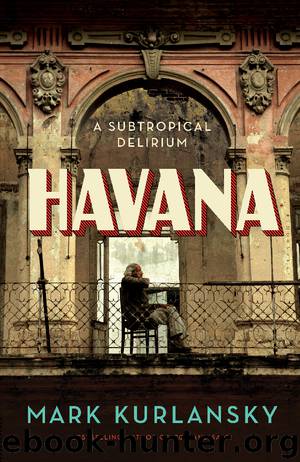Havana by Mark Kurlansky

Author:Mark Kurlansky
Language: eng
Format: epub
Publisher: Bloomsbury Publishing
Published: 2017-07-27T16:00:00+00:00
NINE
The Mulata Returns
Nowadays, no one ever imitates the Russians in Cuba; we have the right to make our own mistakes now.
— EDMUNDO DESNOES, “Donde me pongo” (1967)
In Havana, Oyá, Santería’s African spirit of change and new beginnings, continued to rule. In August 1990, Castro made a speech in which he said that the Soviet Union might be dissolving and that this would mean tremendous hardships, even hunger, for Cuba. But, he said, Cuba would remain true to its ideals and get through what he labeled “a special period in time of peace.” In a democracy, few leaders would have dared to be this candid about impending hard times, but Castro decided to give people bad news in advance.
Castro had offered the worst-case scenario, but he had not exaggerated. The Soviet Union, which had been spending about six billion dollars every year subsidizing the Cuban economy, did collapse. Within a very short period, Cuba lost most of its imports and most of its export earnings. The gross national product declined by more than a third. The island lost most of its energy supply, which had come from Soviet oil. The lack of fuel was particularly critical in Havana, where droughts are compensated for by the costly pumping of underground water. Cars disappeared from the streets; there was nothing for the Chevys and Ladas to run on.
But, like a gift from Oyá, inexpensive Chinese bicycles started appearing all over Havana. And some entrepreneurs built carts—wagons filled with seats—to trail behind the bicycles and transport tourists. These long-railed bicycle rickshaws now filling the narrow streets of Habana Vieja resembled the old-time volantes.
There was also a lack of pharmaceuticals, which had come primarily from East Germany, and, as Castro predicted, there were food shortages. Food rations—a hallmark of revolutionary Cuba—were increased, but even so, the average person in Havana had a diminishing diet. Interestingly, like another gift from Oyá to this very medically conscious society, there was also a noticeable decline in heart attacks and diabetes.
The government looked for ways to rebuild the economy and get past the “special period,” and Cuba decided, as all Caribbean countries eventually do, that tourism was part of the solution. Despite hard times, tourist sites like the Hemingway house were refurbished. (The house was repainted its original cream color instead of the bright white the young revolutionaries had chosen when they took possession.) The government encouraged foreign investments for the first time, though it still had to own at least 51 percent of an enterprise. Hotels were restored. Old mansions were converted into boutique hotels.
Even this very modest introduction of capitalism to the socialist system was a major adjustment for Habaneros. On the one hand, they were being offered an opportunity to improve their situation. On the other, they were being told that government programs were no longer sufficient to look after them. Novelist Pedro Juan Gutiérrez, one of the important chroniclers of this special period, wrote, “We had been locked up in a zoo for thirty-five years.
Download
This site does not store any files on its server. We only index and link to content provided by other sites. Please contact the content providers to delete copyright contents if any and email us, we'll remove relevant links or contents immediately.
Barkskins by Annie Proulx(2885)
Cuba by Lonely Planet(2191)
Fodor's Japan by Fodor's(1057)
The Duppy by Anthony C. Winkler(1054)
Jamaica by Lonely Planet(1046)
Caribbean by James A. Michener(1014)
Moon Guatemala (Moon Handbooks) by Argueta Al(1007)
Puerto Rico by Unknown(1005)
Gorky Park by Martin Cruz Smith(992)
Fodor's Barcelona (Full-color Travel Guide) by Fodor's(967)
Havana Fever by Leonardo Padura(945)
Binging with Babish by Andrew Rea(906)
The World Is Moving Around Me: A Memoir of the Haiti Earthquake by Dany Laferriere(904)
A Trip to the Beach by Melinda Blanchard(901)
The Girl With the Golden Shoes by Colin Channer(884)
The Spice Necklace: My Adventures in Caribbean Cooking, Eating, and Island Life by Vanderhoof Ann(873)
The World is Moving Around Me by Dany Laferriere(871)
Never the Hope Itself by Gerry Hadden(850)
A Voyage to Virginia in 1609 by Strachey William; Jourdain Silvester; Wright Louis B(840)
